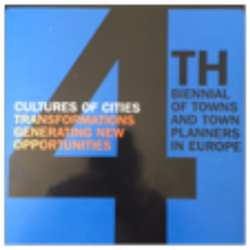Biennial IV - Rotterdam 2001
IV. Rotterdam, Netherlands: 20 to 22 of September 2001

Culture of Cities - Transformations generating new opportunities
The 4th Biennial of Towns and Town Planners in Europe hwas held at the conference centre De Doelen in Rotterdam.
It was made under the theme Culture of cities: transformations that generate new opportunities, focusing on four issues of debate:
• Global forces. The interaction between global forces and local cultures.
• Cultural inheritance. The conservation and development of the cultural and historical legacy.
• Cultural identities. The management of diversity of identities in large European cities.
• Life on the street. New challenges in the design of the public sphere.
Further information
http://www.planum.net/iv-biennal-rotterdam-2001
http://library.wur.nl/WebQuery/groenekennis/1641159
IV Biennal - Rotterdam 2001
Cultures of Cities: a new data bank
The 4th Biennial of Towns and Town Planners in Europe - hold at the conference centre De Doelen in Rotterdam - "Cultures of Cities - Transformations generating new opportunities" - was a successful event involving a lot of town planners and a number of very good projects from all over Europe. This gave rise to the idea of creating a virtual data disseminating information on presented projects.
Bnsp and Nirov - organisers of the Biennial with the Ectp - together with Planum present now free online this new data bank. The biennial issues are divided in two main sections: Projects and Reports. The projects are interesting cases giving a "panorama" of present transformations in European cities. The reports focus on the main themes discussed in Rotterdam, they are very useful in linking considerations begun in the past biennials with the forthcoming one in Barcelona.
The Rotterdam Biennial took place in September 2001 and consisted of a three day seminar and exhibition.
PROJECTS: Virtual exhibition of projects from more than 40 European cities, divided in 4 main topics.
Topic 1 - Global Forces: cultural aspects of globalisation
Topic 2 - Cultural Heritage: development and protection
Topic 3 - Cultural Identities: citizens and cultural encounters
Topic 4 - Street Life: new design for public spaces
REPORTS: The arguments and the reports from the 7 biennial's parallel sessions presented by abstracts, videos and slides.
Parallel Session 1: Globalization around the corner
Parallel Session 2: Cultural heritage – development and protection
Parallel Session 3: Cultural identities
Parallel Session 4: Streetlife, new designs for public spaces
Parallel Session 5: Project development and culture
Parallel Session 6: Public culture and urban planning
Parallel Session 7: Cities and projects
INTRODUCTION TO THE EXHIBITION
by Jan Vogelij - content editor and vice-chairman of the board of the 4th Biennial of Towns and Town Planners
The enthusiastic response to exhibit projects within the four themes of the Biennial underlines the broad interest in spatial planning at the local level throughout Europe.
The selection of exhibited projects however, should not be regarded as an average of European local planning activities for at least two reasons. Not only does the theme 'cultures of cities' focus on a specialized subject but the submitting municipalities are not necessarily a representative group, being characterised as cities that are proud of their achievements and eager to show their results to European colleagues.
It should also be clearly recognized that the exhibition is not able to present a complete overview of European urban planning activities. The reason is that the focus here, is on physical town planning activities which can easily be exhibited by plans, maps, photos, etc. Although social and economic aspects of sustainable urban development are the starting points of many of the projects, those aspects are more difficult to visualise than physical developments.
In general, the Biennial demonstrates the great extent of urban planning activities throughout the European countries. Almost everywhere, the spatial development of the town is gaining (public) attention and (political) priority. Many municipalities organize substantial activities towards meeting with the population and other interest groups, in order to prepare ideas, design plans, organise support, negotiate implementation etc. It seems that whatever term is used for spatial development at the local level - "town planning", "urban development", "urban design" or just "planning" - these activities directed at the city's future physical quality attract a lot of public interest from local society.
A second general remark is that there are fundamental similarities in the focus of urban development policies within European cities. At first glance, a great variety can be attributed to revitalising derelict urban areas, improving the quality of public space, brown field development, reducing the barrier effect of infrastructure, enhancing spatial cohesion, providing new functions for historic constructions and improving accessibility. But all of these planning activities concern the transformation of existing situations. This common denominator is reflected in the spatial policy objectives aimed at revitalising and improving the city itself, at fighting sub urbanisation, urban sprawl and unnecessary land take.
The relation to the theme of the Fourth Biennial of Towns and Town Planners is that culture, in the broad sense of the term, is important in determining the quality of spatial plans and the way in which urban problems are solved.
In this respect the tension between new projects and the existing local context is part of the discussion everywhere.
Two developments illustrate this point. First of all, there are demographic developments taking place in every locality independent and regardless of physical projects. Immigration, for example, is perceived in many localities as an overwhelming threat, posing the question: "what happens to our culture if we become a minority?" Another issue, "what kind of culture will result from the influence of commercial global forces?" is also discernible at the local level.
So, a central question concerns what will become of local cultural identity in the future when confronted with modern developments such as globalisation. If we take the projects of this exhibition under consideration, the impression is that local culture and identity will profit in a positive way.